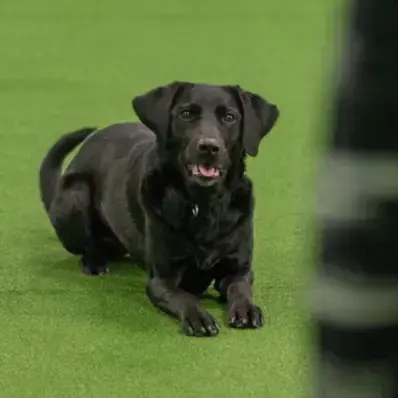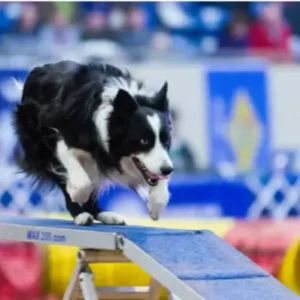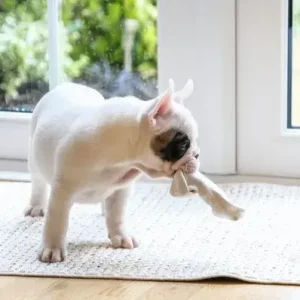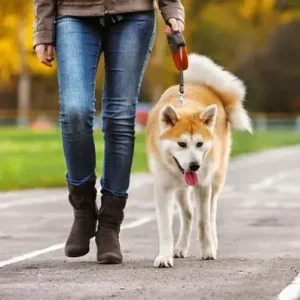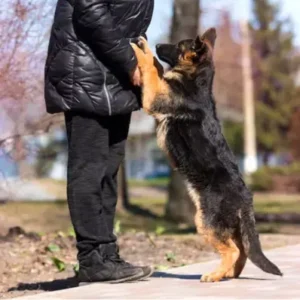Steps to Teach Your Dog to Stay
Training your dog to stay involves patience, consistency, and gradual progress. By following these steps, you can ensure your dog learns this essential command effectively.
Step# 1-Start with the Basics
Before you dive into teaching the “stay” command, make sure your dog has mastered the “sit” command. A dog that reliably sits on cue is better prepared to learn to stay in one place. This foundational obedience skill will set the stage for their success.
Step# 2- Use the "Stay" Command
Now that your dog is comfortable sitting on command, you can introduce the “stay” command:
- Begin with your dog sitting calmly.
- Hold your hand up with your palm facing them as a stop signal and say “stay” in a calm yet firm tone.
- Take one small step back and immediately return to your dog.
- If they remain seated, praise them warmly and reward them with a treat.
Consistency is key at this stage, as your dog learns to associate the verbal and visual cues with the behavior you expect.
Step# 3- Gradually Increase Duration
Building duration is a gradual process that requires short, consistent practice sessions:
- After your dog successfully stays for a few seconds, extend the time little by little.
- Continue to reward them after each successful stay to reinforce the behavior.
- Always release your dog with a clear cue, such as “okay”, “release word” or “come,” to signal that they’re free to move.
Remember, dogs learn best in small, manageable steps, so don’t rush this process.
Step# 4- Add Distance to the Stay Command
Once your dog can reliably stay for longer periods, it’s time to increase the challenge by adding distance:
- Start by stepping back one or two steps after giving the “stay” command.
- Gradually increase the distance, ensuring your dog stays in place each time.
- If your dog breaks the stay, calmly guide them back to the starting position and try again.
With time, your dog will learn to hold their position, even as you move farther away.
Step# 5- Practice the Stay Command with Distractions
To make the “stay” command truly effective, practice in environments with increasing levels of distractions:
- Begin by introducing small distractions, such as background noise or a toy nearby.
- Reward your dog generously for maintaining focus and staying in place.
- Gradually expose them to more challenging distractions, such as other people or pets, while continuing to reinforce the behavior with treats and praise.
Training in different settings helps your dog generalize the “stay” command, ensuring they obey it anywhere.
Common Challenges and Solutions
Teaching your dog to stay can come with challenges. Addressing these obstacles with the right approach is essential. This makes the process smoother and more enjoyable for both you and your dog.
Dog Keeps Breaking the “Stay”
- Go back to shorter durations and smaller distances.
- Ensure you’re not asking too much too soon.
Difficulty Maintaining Focus
- Keep training sessions short (5–10 minutes).
- Train when your dog is alert but not overly excited or tired.
Fear or Anxiety During Training
- Use a calm voice and avoid yelling.
- Make training sessions fun by incorporating playtime afterward.
Tips for Success
To ensure your dog learns the “stay” command effectively, follow these key dog training tips for a successful training experience.
- Be Consistent: Use the same verbal cue, hand signal, and rewards each time.
- End on a Positive Note: Always finish training sessions with success, even if it’s a simple task.
- Practice Daily: Short, regular sessions are more effective than occasional long ones.
Real-Life Applications of the "Stay" Command
The “stay” command can be applied in many practical ways to improve your dog’s behavior and safety:
- Training a Dog to Stay in the Yard: Teach your dog to respect boundaries by practicing the “stay” command near the yard’s edges. Reward them when they remain within the designated area to reinforce the behavior.
- Training a Dog to Stay Off the Couch: Use the “stay” command in combination with “off” to keep your dog off the furniture. Be consistent and reward them when they follow through.
- Training a Dog to Stay in Their Bed: Encourage your dog to stay in their bed by practicing the “stay” command during rest times. Reward them for remaining in place to build positive associations.

